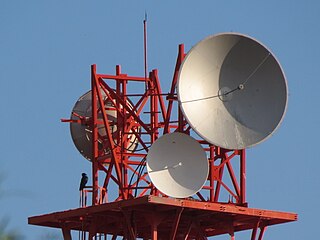Related Research Articles
Public broadcasting involves radio, television and other electronic media outlets whose primary mission is public service. Public broadcasters receive funding from diverse sources including license fees, individual contributions, public financing and commercial financing.
Television in Quebec is a part of the culture of Quebec, with over 99% of households owning a television in Quebec. Long a preferred medium of many of Quebec's actors, artists, and writers, television has been one of the important forces in Quebec society, including its substantial influence in a series of dramatic changes in the 1960s: the Quiet Revolution.

Televisión Española is Spain's national state-owned public television broadcaster and the oldest regular television service in the country. It was also the first regular television service in Equatorial Guinea.

Once is a Mexican educational broadcast television network owned by National Polytechnic Institute. The network's flagship station is XEIPN-TDT channel 11 in Mexico City. It broadcasts across Mexico through nearly 40 TV transmitters and is required carriage on all Mexican cable and satellite providers. The network also operates an international feed which is available in the United States and Venezuela via satellite from DirecTV and CANTV, via online from VEMOX, VIVOplay and also on various cable outlets, on "Latino" or "Spanish" tiers. Most of its programs are also webcast through the Internet, though its programming is not the same as the actual broadcasters or satellite signal.

Telefe is a television station located in Buenos Aires, Argentina. The station is owned and operated by Paramount Global through Televisión Federal S.A. Telefe is also one of Argentina's six national television networks. Its studios are located on Martínez, Buenos Aires, adjacent to the corporate headquarters; its transmitter is located at the Alas Building.
XHAS-TDT is a television station in Tijuana, Baja California, Mexico, affiliated with LATV. It is owned by a Mexican company whose largest single investor is Entravision Communications, a U.S.-based operator of radio and television stations with radio and television stations in San Diego, including Univision affiliate KBNT-CD, and a similar interest in Milenio Televisión affiliate XHDTV-TDT. The transmitter is on Mount San Antonio in Tijuana.
XHDF-TDT, virtual channel 1, is the flagship station of the Azteca Uno television network in Mexico City, Mexico. Azteca Uno can be seen in most major cities in Mexico through TV Azteca's owned-and-operated transmitter network. XHDF provides HD programming to other transmitters and cable and satellite viewers. Azteca Uno also provides the United States Azteca America network with programming which sometimes can be seen simultaneously.

Televisión Pública is a publicly owned Argentine television network, the national public broadcaster. It began broadcasting in 1951, when LR3 Radio Belgrano Televisión channel 7 in Buenos Aires, its key station and the first television station in the country, signed on the air.
Cuba was the first Latin American country to begin television testing in December 1946 when station CM-21P conducted an experimental multi-point live broadcast. The first regular commercial broadcasting began in October 1950 by the small radio station Union Radio, soon followed by other stations. The broadcasts featured sport, soap operas, news, cooking shows, and comedy. Censorship was imposed following the 1952 coup by Fulgencio Batista, and again by the government of the Cuban revolution after their victory in 1959.

XHTVM-TDT is a television station in Mexico City, owned by Televisora del Valle de México and operated by TV Azteca. It is branded as adn40 and available over the air in much of Mexico on TV Azteca's transmitters. Programming generally consists of news and informational shows.

Telenica is a nationwide state-run terrestrial television channel from Nicaragua, founded by Nicaraguan businessman Carlos Briceño in 1992. The channel was bought by Juan Carlos Ortega Murillo in late 2009, yet it was not made public until January 2010, the change in ownership led to a change in profile. TN8 is one of Nicaragua's main channels.

Television is one of the major mass media of Argentina. As of 2019, household ownership of television sets in the country is 99%, with the majority of households usually having two sets. Cable television has become the most used type of delivering, with 73.2% of households having a cable provider.
Television in Spain was introduced in 1956, when the national state-owned public service television broadcaster Televisión Española (TVE) started regular analog free-to-air terrestrial black and white broadcasts. Colour transmissions started in 1972 after two years of test transmissions, with all programming transmitted in color in 1977, and colour commercials starting in 1978. TVE held a monopoly on television broadcasting until regional public channels were launched during the 1980s and commercial television started nationwide in 1990. Digital terrestrial television was launched on 30 November 2005 with analog service discontinued on 3 April 2010. Currently, television is one of the leading mass media of the country, and by 2008 was in 99.7% of households in Spain according to INE statistics.

FETV is a television network that broadcasts on channel 5 in Panama City, and is headquartered in Panama City, Panama, with repeaters throughout the country. The network and stations broadcast in the NTSC format. The network takes its name from the Television Education Foundation (FETV), its owner.
Azteca Uno, is a Mexican national broadcast television network owned by TV Azteca, with more than 100 transmitters across the country. Azteca Uno broadcasts on virtual channel 1. Azteca Uno programming is available in Mexico on satellite via Sky and Dish Network, as well as all Mexican cable systems, and some Azteca Uno programming were seen in the United States on Azteca América.

Canal 26 is a television station in Aguascalientes City, Mexico. It was established on October 12, 1976, with the support of the Instituto Cultural de Aguascalientes. It is part of Radio y Televisión de Aguascalientes, the public television and radio broadcaster for the state.
Televisión y Radio de Campeche (TRC) is the state broadcaster of the Mexican state of Campeche, retransmit the programming of Canal 44 de Guadalajara and Canal Once.

The Sistema Público de Radiodifusión del Estado Mexicano until 2014, is an independent Mexican government agency. Its mission is to support the development of public broadcasting in the country and expand its coverage. It carries out this goal through ownership of a nationwide network of transmitters and the management of its own public television channel, Canal Catorce. It also owns four radio transmitters.

Radio in Mexico is a mass medium with 98 percent national penetration and a wider diversity of owners and programming than on television. In a model similar to that of radio in the United States, Mexican radio in its history has been largely commercial, but with a strong state presence and a rising number of noncommercial stations in the 2000s and early 2010s. In August 2015, there were 1,999 legal radio stations, almost 75 percent of them on the FM band.

Canal 3 is the first commercial TV station and the second overall station in Guatemala. It began its TV service in 1956.
References
- 1 2 "18 de septiembre de 1955: se realiza la primera transmisión oficial por televisión en Guatemala". Hoy Historia GT (in Spanish). September 18, 2020. Retrieved October 20, 2020.
- 1 2 Lucas Cajas, Cicibel (2012). "La televisión en Guatemala" (PDF). p. 6. Retrieved October 20, 2020.
- 1 2 Estrada García de Loarca, María del Rosario (2005). "La televisión en Guatemala" (PDF). pp. 27-28 (38-39). Retrieved October 20, 2020.